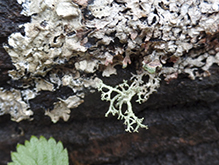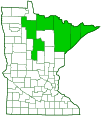Common Antler Lichen
(Pseudevernia consocians)
Conservation • Description • Ecology • Distribution • Taxonomy
Conservation Status |
|
|||||||
| IUCN Red List | not listed |
|||||||
| NatureServe | NNR - Unranked |
|||||||
| Minnesota | not listed |
|||||||
Description |
||
Common Antler Lichen occurs in the United States from Maine to Minnesota, adjacent Canadian provinces, and south along the foothills of the Appalachian Mountains. In Minnesota it is restricted to the northeast and north central regions. It grows in open comiferous and mixed forests on the bark of coniferous trees, especially pine, but also black spruce, tamarack, and white cedar. The vegetative body (thallus) is 1½″ to 4″ (0.5 to 1.5 mm) wide and divided into overlapping, flattened lobes. It appears shrubby (fruticose) but it might be more appropriate to call it leafy (foliose). It is anchored to the substrate (bark) by a single central peg (holdfast). There are no root-like structures (rhizines). The lobes are long and narrow, 1 ⁄64″ to 1 ⁄16″ wide, with more or less parallel sides (linear). They are repeatedly branched, mostly with forked branches (dichotomously). The margins do not have a fringe of hairs. The upper surface is pale gray, smooth or wrinkled, shiny or dull, and lightly spotted. It appears somewhat rough due to abundant but minute granules (isidia). The lower surface is dark gray or black and broadly channeled. Cup-like or disk-shaped fruiting bodies (apothecia) are rarely present. |
||
Similar Species |
||
Ecology |
||
Substrate |
||
Trees |
||
Growth Form |
||
Fruticose |
||
Habitat |
||
Wet coniferous and mixed forests |
||
Hosts |
||
Coniferous trees |
||
Distribution |
||||
|
Sources |
|||
| 5/29/2022 | ||||
Occurrence |
||||
|
||||
Taxonomy |
|||
| Kingdom | Fungi (fungi) | ||
| Subkingdom | Dikarya | ||
| Phylum | Ascomycota (sac fungi) | ||
| Subphylum | Pezizomycotina (sac fungi amd lichens) | ||
| Class | Lecanoromycetes (common lichens) | ||
| Subclass | Lecanoromycetidae (shield lichens, sunburst lichens, rosette lichens, and allies) | ||
Order |
Lecanorales (shield lichens, rim lichens, and allies) | ||
Suborder |
Lecanorineae | ||
Family |
Parmeliaceae (shield lichens and allies) | ||
| Subfamily | Parmelioideae (typical shield lichens) | ||
Genus |
Pseudevernia | ||
| Mycobiont | Pseudevernia consocians | ||
| Photobiont | |||
Synonyms |
|||
|
|||
Common Names |
|||
Common Antler Lichen |
|||
Glossary
Apothecium
An open, disk-shaped or cup-shaped, reproductive structure, with spore sacs on the upper surface, that produces spores for the fungal partner of a lichen. Plural: apothecia.
Fruticose
Shrubby: referring to the growh form of lichens that may be tufted, draped, or stalked.
Holdfast
In lichens: A central peg-like projection of the thallus, like an umbilical cord, that anchors the lichen to the substrate.
Isidium
An asexual reproductive structure of a lichen in the form of a tiny outgrowth of the upper cortex. It consists of a cluster of algal cells (the photobiont) wrapped in fungal filaments (the mycobiont), and a shiny outer layer of protective tissue (cortex). Plural: isidia.
Linear
Long, straight, and narrow, with more or less parallel sides, like a blade of grass.
Rhizine
A root-like structure of a lichen that attaches the lower layer to the substrate.
Thallus
The vegetative body of a lichen composed of both the alga and the fungus.
Visitor Photos |
|||||
Share your photo of this fungus. |
|||||
| This button not working for you? Simply email us at info@MinnesotaSeasons.com. Attach one or more photos and, if you like, a caption. |
|||||
Luciearl |
|||||
 |
|||||
MinnesotaSeasons.com Photos |
|||||
|
|||||

Slideshows |
||

Visitor Videos |
|||
Share your video of this fungus. |
|||
| This button not working for you? Simply email us at info@MinnesotaSeasons.com. Attach a video, a YouTube link, or a cloud storage link. |
|||
Other Videos |
|||

Created: 11/18/2018
Last Updated:


